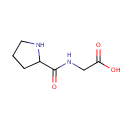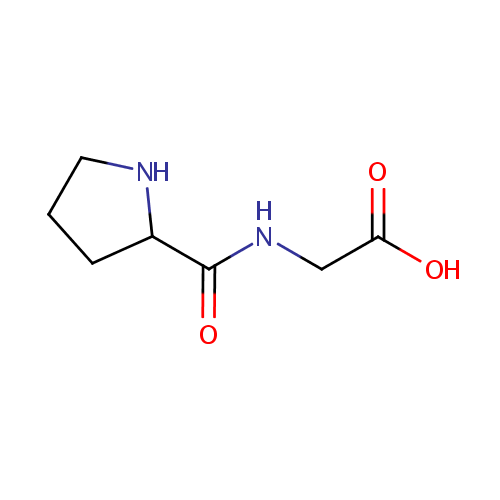
L-Prolinylglycine (PAMDB001645)
| Record Information | |||||||||||||||||||||||||||||||||||||||||||||||||||||||||||||
|---|---|---|---|---|---|---|---|---|---|---|---|---|---|---|---|---|---|---|---|---|---|---|---|---|---|---|---|---|---|---|---|---|---|---|---|---|---|---|---|---|---|---|---|---|---|---|---|---|---|---|---|---|---|---|---|---|---|---|---|---|---|
| Version | 1.0 | ||||||||||||||||||||||||||||||||||||||||||||||||||||||||||||
| Update Date | 1/22/2018 11:54:54 AM | ||||||||||||||||||||||||||||||||||||||||||||||||||||||||||||
| Metabolite ID | PAMDB001645 | ||||||||||||||||||||||||||||||||||||||||||||||||||||||||||||
| Identification | |||||||||||||||||||||||||||||||||||||||||||||||||||||||||||||
| Name: | L-Prolinylglycine | ||||||||||||||||||||||||||||||||||||||||||||||||||||||||||||
| Description: | Prolinylglycine is a dipeptide. It is a proteolytic breakdown product of larger proteins. Pseudomonas aeruginosa can use this dipeptide as a substrate for carbon/nitrogen metabolism and a source of proline. It is transported via DppA, which appears to be both a dipeptide transporter and a dipeptidase. Pro-Gly utilization does not require any of the three major proline transport systems. [PMID:1702779] | ||||||||||||||||||||||||||||||||||||||||||||||||||||||||||||
| Structure | |||||||||||||||||||||||||||||||||||||||||||||||||||||||||||||
| Synonyms: |
| ||||||||||||||||||||||||||||||||||||||||||||||||||||||||||||
| Chemical Formula: | C7H12N2O3 | ||||||||||||||||||||||||||||||||||||||||||||||||||||||||||||
| Average Molecular Weight: | 172.1818 | ||||||||||||||||||||||||||||||||||||||||||||||||||||||||||||
| Monoisotopic Molecular Weight: | 172.08479226 | ||||||||||||||||||||||||||||||||||||||||||||||||||||||||||||
| InChI Key: | RNKSNIBMTUYWSH-UHFFFAOYSA-N | ||||||||||||||||||||||||||||||||||||||||||||||||||||||||||||
| InChI: | InChI=1S/C7H12N2O3/c10-6(11)4-9-7(12)5-2-1-3-8-5/h5,8H,1-4H2,(H,9,12)(H,10,11) | ||||||||||||||||||||||||||||||||||||||||||||||||||||||||||||
| CAS number: | 2578-57-6 | ||||||||||||||||||||||||||||||||||||||||||||||||||||||||||||
| IUPAC Name: | 2-(pyrrolidin-2-ylformamido)acetic acid | ||||||||||||||||||||||||||||||||||||||||||||||||||||||||||||
| Traditional IUPAC Name: | (pyrrolidin-2-ylformamido)acetic acid | ||||||||||||||||||||||||||||||||||||||||||||||||||||||||||||
| SMILES: | OC(=O)CNC(=O)C1CCCN1 | ||||||||||||||||||||||||||||||||||||||||||||||||||||||||||||
| Chemical Taxonomy | |||||||||||||||||||||||||||||||||||||||||||||||||||||||||||||
| Taxonomy Description | This compound belongs to the class of organic compounds known as peptides. These are compounds containing an amide derived from two or more amino carboxylic acid molecules (the same or different) by formation of a covalent bond from the carbonyl carbon of one to the nitrogen atom of another. | ||||||||||||||||||||||||||||||||||||||||||||||||||||||||||||
| Kingdom | Organic compounds | ||||||||||||||||||||||||||||||||||||||||||||||||||||||||||||
| Super Class | Organic acids and derivatives | ||||||||||||||||||||||||||||||||||||||||||||||||||||||||||||
| Class | Carboxylic acids and derivatives | ||||||||||||||||||||||||||||||||||||||||||||||||||||||||||||
| Sub Class | Amino acids, peptides, and analogues | ||||||||||||||||||||||||||||||||||||||||||||||||||||||||||||
| Direct Parent | Peptides | ||||||||||||||||||||||||||||||||||||||||||||||||||||||||||||
| Alternative Parents | |||||||||||||||||||||||||||||||||||||||||||||||||||||||||||||
| Substituents |
| ||||||||||||||||||||||||||||||||||||||||||||||||||||||||||||
| Molecular Framework | Aliphatic heteromonocyclic compounds | ||||||||||||||||||||||||||||||||||||||||||||||||||||||||||||
| External Descriptors | Not Available | ||||||||||||||||||||||||||||||||||||||||||||||||||||||||||||
| Physical Properties | |||||||||||||||||||||||||||||||||||||||||||||||||||||||||||||
| State: | Solid | ||||||||||||||||||||||||||||||||||||||||||||||||||||||||||||
| Charge: | 0 | ||||||||||||||||||||||||||||||||||||||||||||||||||||||||||||
| Melting point: | Not Available | ||||||||||||||||||||||||||||||||||||||||||||||||||||||||||||
| Experimental Properties: |
| ||||||||||||||||||||||||||||||||||||||||||||||||||||||||||||
| Predicted Properties |
| ||||||||||||||||||||||||||||||||||||||||||||||||||||||||||||
| Biological Properties | |||||||||||||||||||||||||||||||||||||||||||||||||||||||||||||
| Cellular Locations: | Cytoplasm | ||||||||||||||||||||||||||||||||||||||||||||||||||||||||||||
| Reactions: | |||||||||||||||||||||||||||||||||||||||||||||||||||||||||||||
| Pathways: | Not Available | ||||||||||||||||||||||||||||||||||||||||||||||||||||||||||||
| Spectra | |||||||||||||||||||||||||||||||||||||||||||||||||||||||||||||
| Spectra: |
| ||||||||||||||||||||||||||||||||||||||||||||||||||||||||||||
| References | |||||||||||||||||||||||||||||||||||||||||||||||||||||||||||||
| References: |
| ||||||||||||||||||||||||||||||||||||||||||||||||||||||||||||
| Synthesis Reference: | Not Available | ||||||||||||||||||||||||||||||||||||||||||||||||||||||||||||
| Material Safety Data Sheet (MSDS) | Not Available | ||||||||||||||||||||||||||||||||||||||||||||||||||||||||||||
| Links | |||||||||||||||||||||||||||||||||||||||||||||||||||||||||||||
| External Links: |
| ||||||||||||||||||||||||||||||||||||||||||||||||||||||||||||
Enzymes
- General function:
- Involved in proteolysis
- Specific function:
- Aminopeptidase N is involved in the degradation of intracellular peptides generated by protein breakdown during normal growth as well as in response to nutrient starvation
- Gene Name:
- pepN
- Locus Tag:
- PA3083
- Molecular weight:
- 100 kDa
Reactions
| Release of an N-terminal amino acid, Xaa-|-Yaa- from a peptide, amide or arylamide. Xaa is preferably Ala, but may be most amino acids including Pro (slow action). When a terminal hydrophobic residue is followed by a prolyl residue, the two may be released as an intact Xaa-Pro dipeptide. |
- General function:
- Involved in aminopeptidase activity
- Specific function:
- Presumably involved in the processing and regular turnover of intracellular proteins. Catalyzes the removal of unsubstituted N-terminal amino acids from various peptides. Required for plasmid ColE1 site-specific recombination but not in its aminopeptidase activity. Could act as a structural component of the putative nucleoprotein complex in which the Xer recombination reaction takes place
- Gene Name:
- pepA
- Locus Tag:
- PA3831
- Molecular weight:
- 52.3 kDa
Reactions
| Release of an N-terminal amino acid, Xaa-|-Yaa-, in which Xaa is preferably Leu, but may be other amino acids including Pro although not Arg or Lys, and Yaa may be Pro. Amino acid amides and methyl esters are also readily hydrolyzed, but rates on arylamides are exceedingly low. |
| Release of an N-terminal amino acid, preferentially leucine, but not glutamic or aspartic acids. |
- General function:
- Involved in transporter activity
- Specific function:
- Part of the binding-protein-dependent transport system for dipeptides; probably responsible for the translocation of the substrate across the membrane
- Gene Name:
- dppB
- Locus Tag:
- PA4503
- Molecular weight:
- 37 kDa
- General function:
- Involved in transporter activity
- Specific function:
- Part of the binding-protein-dependent transport system for dipeptides; probably responsible for the translocation of the substrate across the membrane
- Gene Name:
- dppC
- Locus Tag:
- PA4504
- Molecular weight:
- 32.4 kDa
- General function:
- Involved in nucleotide binding
- Specific function:
- Part of the binding-protein-dependent transport system for dipeptides. Probably responsible for energy coupling to the transport system
- Gene Name:
- dppD
- Locus Tag:
- PA4505
- Molecular weight:
- 35.4 kDa
- General function:
- Involved in nucleotide binding
- Specific function:
- Part of the binding-protein-dependent transport system for dipeptides. Probably responsible for energy coupling to the transport system
- Gene Name:
- dppF
- Locus Tag:
- PA4506
- Molecular weight:
- 36.3 kDa
- General function:
- Involved in transporter activity
- Specific function:
- Dipeptide-binding protein of a transport system that can be subject to osmotic shock. DppA is also required for peptide chemotaxis
- Gene Name:
- dppA
- Locus Tag:
- PA4496
- Molecular weight:
- 60.1 kDa
Transporters
- General function:
- Involved in proteolysis
- Specific function:
- Aminopeptidase N is involved in the degradation of intracellular peptides generated by protein breakdown during normal growth as well as in response to nutrient starvation
- Gene Name:
- pepN
- Locus Tag:
- PA3083
- Molecular weight:
- 100 kDa
Reactions
| Release of an N-terminal amino acid, Xaa-|-Yaa- from a peptide, amide or arylamide. Xaa is preferably Ala, but may be most amino acids including Pro (slow action). When a terminal hydrophobic residue is followed by a prolyl residue, the two may be released as an intact Xaa-Pro dipeptide. |
- General function:
- Involved in transporter activity
- Specific function:
- Part of the binding-protein-dependent transport system for dipeptides; probably responsible for the translocation of the substrate across the membrane
- Gene Name:
- dppB
- Locus Tag:
- PA4503
- Molecular weight:
- 37 kDa
- General function:
- Involved in transporter activity
- Specific function:
- Part of the binding-protein-dependent transport system for dipeptides; probably responsible for the translocation of the substrate across the membrane
- Gene Name:
- dppC
- Locus Tag:
- PA4504
- Molecular weight:
- 32.4 kDa
- General function:
- Involved in nucleotide binding
- Specific function:
- Part of the binding-protein-dependent transport system for dipeptides. Probably responsible for energy coupling to the transport system
- Gene Name:
- dppD
- Locus Tag:
- PA4505
- Molecular weight:
- 35.4 kDa
- General function:
- Involved in nucleotide binding
- Specific function:
- Part of the binding-protein-dependent transport system for dipeptides. Probably responsible for energy coupling to the transport system
- Gene Name:
- dppF
- Locus Tag:
- PA4506
- Molecular weight:
- 36.3 kDa
- General function:
- Involved in transporter activity
- Specific function:
- Dipeptide-binding protein of a transport system that can be subject to osmotic shock. DppA is also required for peptide chemotaxis
- Gene Name:
- dppA
- Locus Tag:
- PA4496
- Molecular weight:
- 60.1 kDa

